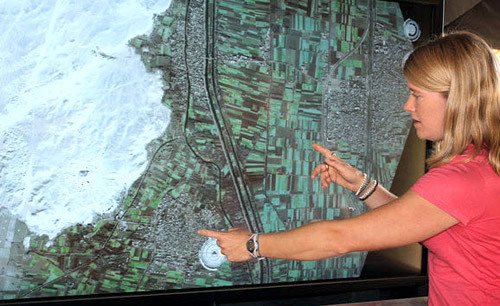The 21st Century Indiana Jones is a Woman Crowdsourcing Space Archaeology

Egyptian Pyramids captured by DubaiSat-1 of EIAST, Dubai.
Sarah Parcak’s innovative work in space archaeology has earned her the nickname “the Indiana Jones of the 21st century.” When she appeared—wearing Indian Jones’ iconic hat—on The Late Show with Stephen Colbert in January, the host referred to her as a “space archaeologist wizard genius.” In November 2015, she was awarded the 2016 TED Prize and $1 million.
This week, she has announced her plans for the prize money: She’s giving us all a chance to become amateur space archaeologists.
Parcak is a pioneer in her field, which involves repurposing military satellites to find previously undiscovered ancient ruins. By examining high-resolution satellite imagery with algorithms developed via trial-and-error, Parcak and her team have discovered 17 pyramids, 1,000 tombs, and over 3,100 settlements in Egypt alone. Now, she’s interested in using the tools of space archaeology to help preserve these sites and ensure humanity’s cultural heritage remains in evidence.
After the Egyptian uprising against Hosni Mubarak began in 2011, Parcak and her colleagues noticed an alarming rise in looting at archaeological sites—a 520 percent increase from 2011 to 2012, according to National Geographic. In 2015, reports emerged of ISIS destroying ancient sites and looting artifacts to sell on the black market. Parcak has partnered with crowdsourcing experts to develop Global Xplorer, a digital platform that will crowdsource the discovery and protection of ancient sites using satellite imagery.
How will this work? First, her team will process and upload satellite imagery to the system. Users who access the system will then be given a deck of images each showing a small plot of land, with clues, keys, and examples to help them analyze the imagery. The users will tag imagery that appears to show new sites or evidence of looting at existing sites; after enough users tag an image, Parcak’s team will verify the discovery.

Sarah Parcak points out ancient sites in satellite imagery.
As Parcak explains to NPR, the platform will give her access to millions of fresh eyes to perform the tedious analysis technique her team already uses. “The biggest problem we have when looking at satellite imagery is not the processing,” she says. “The hardest part is actually eye fatigue. … Imagine hours and hours looking at satellite imagery. We miss things.”
Parcak is also hoping field archaeologists will use apps like Periscope, Twitter, or Google Hangouts when they visit dig sites, sharing the footage through Global Xplorer. As she notes in her message on the Global Xplorer site:
- A hundred years ago archaeology was for the rich, 50 years ago it was for men, and now it’s mainly for academics. But archaeology can be for everyone. We can crowdsource exploration and speed up the process of discovering and protecting ancient sites.
Parcak’s ambitious plan to democratize archaeological discovery has received considerable praise, with the National Geographic Society’s Christopher Thorton telling National Geographic, “This is a huge opportunity to educate the public on things that we know about looting because we are deeply embedded in this world.”
Parcak hopes to launch Global Xplorer later this year, so plan to pick up your Indiana Jones costume soon.
Оставить комментарий
Для комментирования необходимо войти через ![]() Вконтакте
Вконтакте
